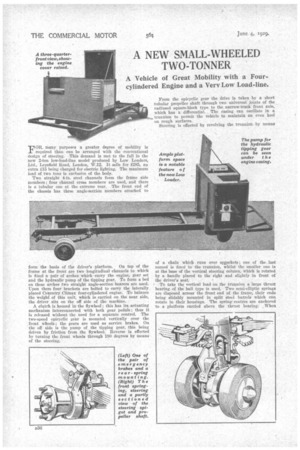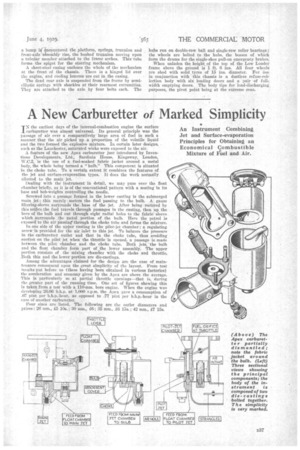A NEW SMALL-WHEELED TWO-TONNER
Page 62

Page 63

If you've noticed an error in this article please click here to report it so we can fix it.
A Vehicle of Great Mobility with a Fourcylindered Engine and a Very Low Load-line.
"Cl OR many purposes a greater degree of mobility is
required than can be arranged with the conventional design of steering. This demand is met to the full in the new 2-ton low-load-line model produced by Low Loaders, Ltd., Leysfield Road, London, W.I2. It sells for £285, an extra £15 being charged for electric lighting. The maximum load of two tons is exclusive of the body.
Two straight 4-in, steel channels form the frame side members; four channel cross members are used, and there is a tubular one at the extreme rear. The front end of the chassis has three angle-section members attached to
form the basis of the driver's platform. On top of the frame at the front are two longitudinal channels to which is fixed a pair of arches which carry the engine, gear set and the hydraulic pump of the tipping gear. To form a bed on these arches two straight angle-section bearers are used. Upon them four brackets are bolted to carry the laterally placed C6TentrY Climax four-cylindered engine. To balance the weight of this unit, which is carried on the near side, the driver sits on the off side of the machine.
A clutch is housed in the flywheel ; this has its actuating mechanism interconnected with both gear pedals ; thus it is released without the need for a separate control. The two-speed epicyclic gear is mounted vertically over the front wheels ; the gears are used as service brakes. On the off side is the pump of the tipping gear, this being driven by friction from the flywheel. Reverse is effected by turning the front wheels through 180 degrees by means of the steering. From the epicyclic gear the drive is taken by a short tubular propeller shaft through two universal joints of the radiused square-block type to the narrow-track front axle, which has a differential. The casing can oscillate in a trunnion to permit the vehicle to maintain an even keel on rough surfaces.
Steering is effected by revolving the trunnion by means of a chain which runs over spreckets ; one of the last named is fixed to the trunnion, whilst the smaller one is at the base of the vertical steering column, which is rotated by a handle placed to the right and slightly in front of the driver's seat.
• To take the vertical load on the trunnion a large thrust bearing of the ball type is used. Two semi-elliptic springs are disposed across the front end of the frame, their ends being slidably mounted in split steel barrels which can rotate in their housings. The springcentres are anchored to a platform carried above the thrust bearing. When
a hump isr enceuntered the .platform, Springs, trunnion and front-axle'-aiSetablY rise: the bushed trunnion moving upon a tubular member attached to the frame arches. This tube forms the spigot for the steering mechanism.
A sheet-steel casing encloses the whole of the mechanism at the front of the chassis. There is a hinged lid over the engine, and cooling louvres are cut in the casing.
The dead rear axle is suspended from the frame by semielliptic springs with shackles at their rearmost extremities. They are attached to the axle by four bolts each. The hubs run on double-row ball and single-row roller bearings; the wheels are bolted to the hubs, the bosses of which form the drums for the single-shoe pull-on emergency brakes.
When unladen the height of the top of the Low Loader frame above the ground i 1 ft. 6 ins. All four wheels are shod with solid tyres of 15 ins. diameter. For Use in conjunction with this chassis is a dustless refuse-collection body with six loading doors and a pair of f allwidth emptying doors. The body tips for load-discharging purposes, the pivot point being at the extreme rear.




















































































































